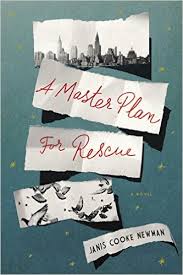A Master Plan for Rescue: A Novel
- By Janis Cooke Newman
- Riverhead Books
- 322 pp.
- Reviewed by Taylor Lea Hicks
- August 28, 2015
A dazzling portrait of a world — and hearts — on the brink.

In A Master Plan for Rescue, as in her first historical-fiction novel, Mary: Mrs. A Lincoln, Janis Cooke Newman immerses readers in a particular time period. In this latest work, set in 1942 Manhattan and pre-World War II Berlin, we follow the converging stories of Jack and Jakob as they seek to make a difference in the world.
Jack, an idealistic boy from NYC and the book’s primary narrator, is coping with the loss of his eyesight and his father by searching for Nazis with his code-o-graph. His sometimes charming, sometimes irritating naivety is the reader’s rudder for the majority of the book as he strives to navigate the changes in his life and his city. His journey from the innocent view of a child to the complex, oftentimes dark view of the adult world is an emotional one.
A Jew having fled Berlin, Jakob spent his life fixing things until encountering the only one he couldn’t — his beloved Rebecca’s weakening heart. He watches as both his country and his relationship come apart, and reaches America determined to make an impact back home. When he and Jack eventually meet, the two draw on their mutual grief and hopefulness to hatch a fantastical scheme — one meant to bring doomed children out of Europe via submarine.
Though delicately written, the book begins with a confusing, oddly phrased first chapter. The following chapters, however, are smoother, full of amazing language and foreshadowing, such as in this passage narrated by Jack:
“Once I began to see the radio, I did nothing but listen to it. Every afternoon, before the glass tubes had warmed enough to catch sound, I’d be waiting on the checkerboard linoleum, waiting to see the purple and gold pennants of Jack Armstrong’s All-American high school whipping in the wind, the knockout gas billowing from the end of the Green Hornet’s gun like steam rising from subway gratings. I’d remain in front of the radio until my mother called me into the kitchen for dinner, but as soon as I could, I’d be back, the music from Death Valley Days filling my ears, my eyes trained on a distant line of covered wagons rolling across a sun-blasted landscape.”
Many chapters are told from perspectives other than Jack’s, which, although awkward at first, gives the story a solid foundation. For example, Jakob recalls this episode from his own life in Nazi Berlin: “We went running down the street, but when I heard the SA man’s boots behind us, I pulled us off the road and into the yards of the houses the rich Jews had built to protect themselves from all the terrible things that have happened to Jews throughout history. The terrible things they did not realize they could not protect themselves from. Not by money. Not by staying away from politics. Not by anything except not being a Jew.”
As elsewhere in the book, the prose here is authentic, powerful, and piercing, lifting the characters’ voices to the highest level. While the resolution of the novel’s titular “plan for rescue,” what should be a significant moment in the story, feels a bit rushed and confusing, it makes the book no less satisfying.
Though occasionally unbalanced, A Master Plan for Rescue is a gritty, lovely look at a worldwide turning point and how it affected the lives of the people back home. In it, Newman opens readers’ eyes to the tragedies of daily life during wartime, and to the many ways those lives can come together to do something meaningful.
Taylor Lea Hicks has a B.A. in creative writing from the University of Central Arkansas and is a current student in the MFA program at Stony Brook Southampton. Her work has been published in Gandy Dancer, the Portland Review, Circa Magazine, and TSR – the Southampton Review. You can follow her on Twitter at @taylorleahicks or email her at [email protected].

